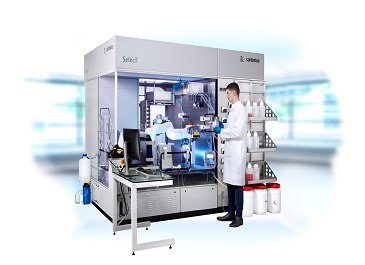Sartorius launches new automated cell culture system
January 25, 2016 | Monday | News | By BioSpectrum Bureau
Sartorius launches new automated cell culture system
The SelecT Mk5 system's new Low Volume Reagent Dispensing Option provides chilled storage for up to 6 different reagents
Sartorius launched the new SelecT Mk5 automated cell culture system for the routine production of high quality complex cell lines on Booth 1223 at the Society for Laboratory Automation and Screening (SLAS) Conference in San Diego, USA, held from Jan23-27, 2016.
On the booth, the Sartorius team detailed how the new SelecT system has been extensively redesigned to upgrade its flask handling and pipetting capabilities, and now comes with an integrated Vi-CELL Cell Viability Analyser and a new Low Volume Reagent Dispensing module. They explained why this makes the SelecT Mk5 system an ideal choice for scientists looking for an established method of continuous, unattended large-scale culturing of reproducible assay-ready multiwell plates, and can also support the maintenance and expansion of cell lines requiring more complex handling, such as stem cells.
The Vi-CELL was chosen for the new SelecT because the technology adapts well to the online automated measurement of cell viability and cell number required by SelecT. With the integrated Vi-CELL analyser, scientists can review numerical and image data in real time or while also having access to additional cell culture data provided by the SelecT system. The SelecT can use cell count data to automate media additions based on threshold values or seed new flasks with defined numbers of cells, providing a truly walk away cell culture system with a built-in feedback loop.
The SelecT Mk5 system's new Low Volume Reagent Dispensing Option provides chilled storage for up to 6 different reagents and a new pipette adaptor allows 100µl-1ml to be aseptically dispensed into T-flasks. Using this feature, scientists can schedule SelecT to automatically add small quantities of expensive reagents, such as growth factors, and transfection or differentiation reagents, to their cell lines without having to load regents immediately before use.
Dr Dave Thomas, SelecT Product Manager commented, "SelecT was introduced to the market 10 years ago, and over the past decade automated cell culture has changed. Scientists are now routinely culturing primary cells or stem cells that require constant monitoring, as well as the increasing use of high cost media components. By transferring the capabilities of our smaller scale cell culture system, the CompacT SelecT, to the larger SelecT platform, the system has evolved from simply supplying assay-ready plates to high throughput screening facilities into a system that can now support the cell culture tasks that our customers can see becoming more important over the next decade.".
Dr Thomas continued, "Following feedback from SelecT users, we have invested considerable resources and almost two years in developing this new system, which we're delighted to be introducing at SLAS. This investment in SelecT ensures the system can continue to support core cell culture facilities and users requiring large scale R&D cell culture capabilities. It also allows low or medium throughput facilities and users of our CompacT SelecT systems to seamlessly scale production to a larger system as their cell culture demands grow. For users wishing to transition R&D cell culture activities into more clinical applications, or for the production or biologics, many of the key design features that allow aseptic processing and cross contamination control are also present in our Cellmate automated cell culture system, that has been used in the manufacture of licensed products for the past 25 years. We look forward to welcoming scientists on Booth 1223 to discuss how the new SelecT Mk5 could help them produce consistent quality cell lines for a wide range of their drug screening applications."










